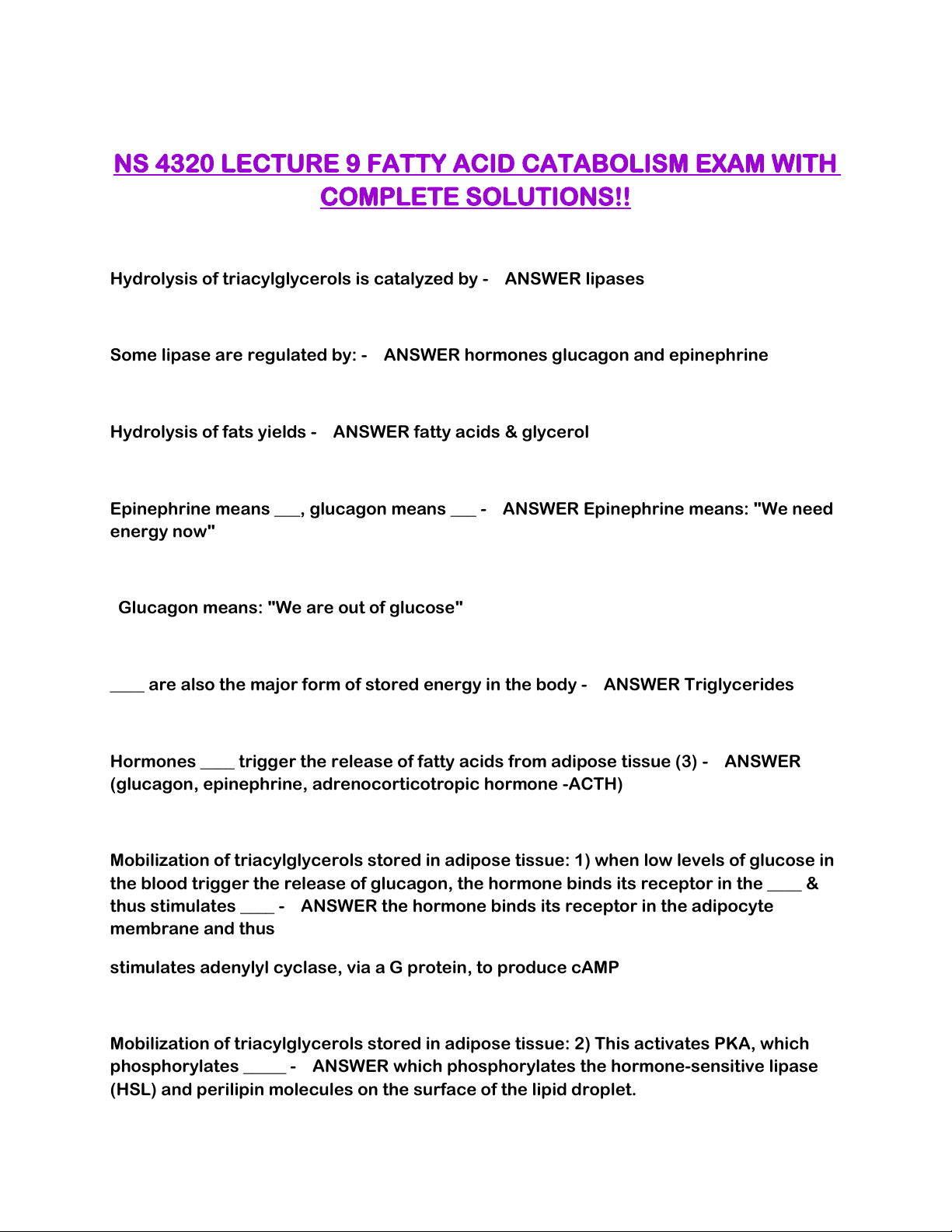
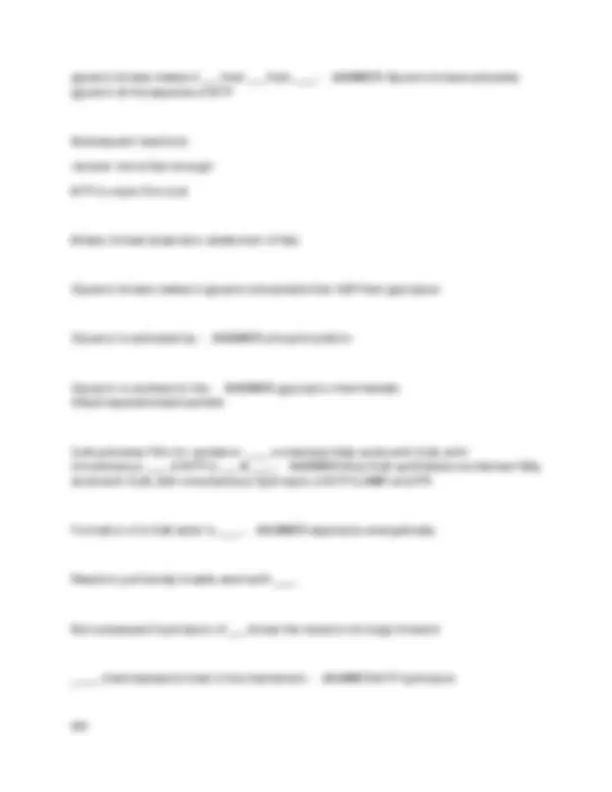
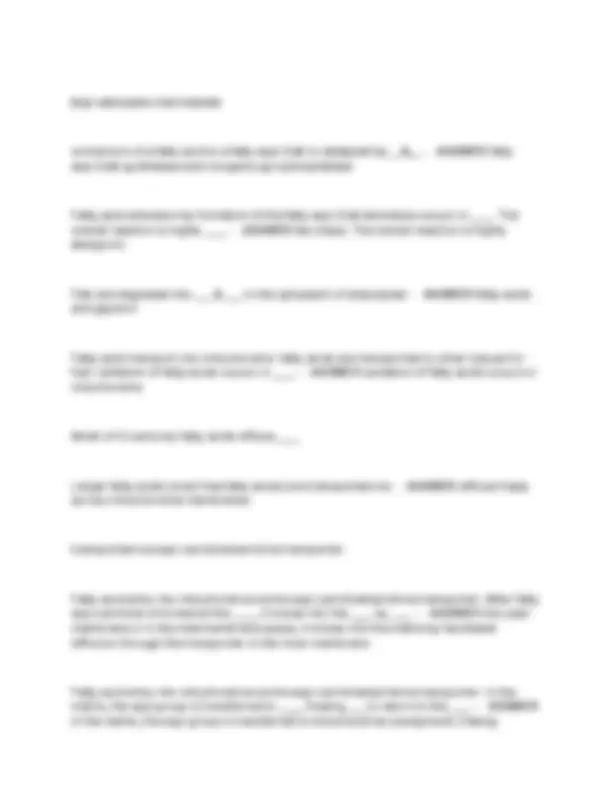
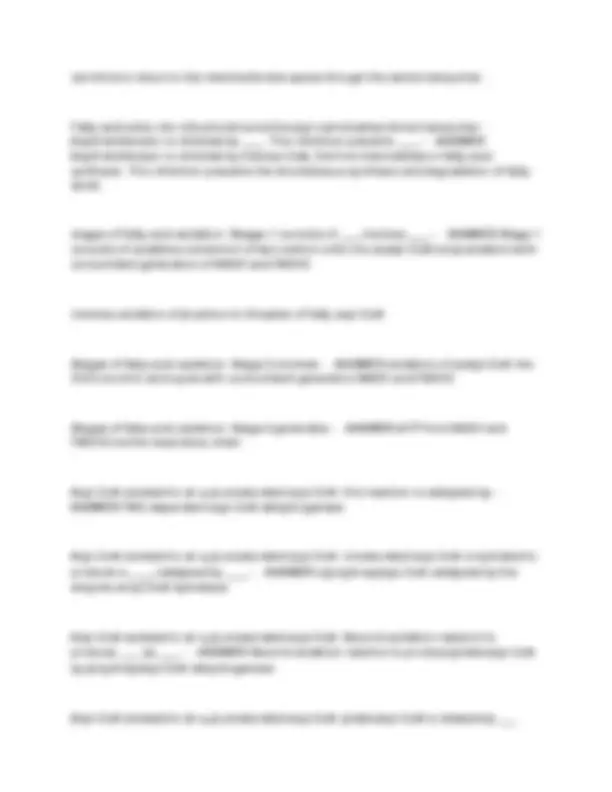

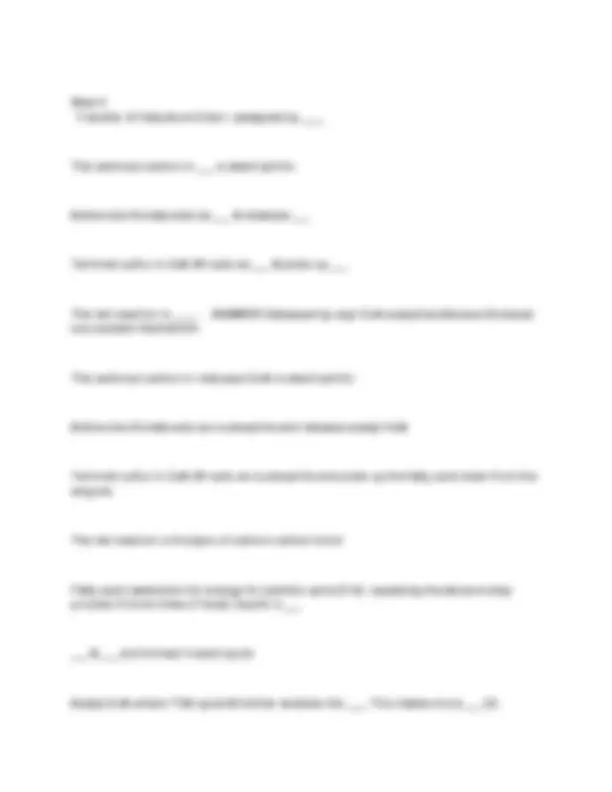

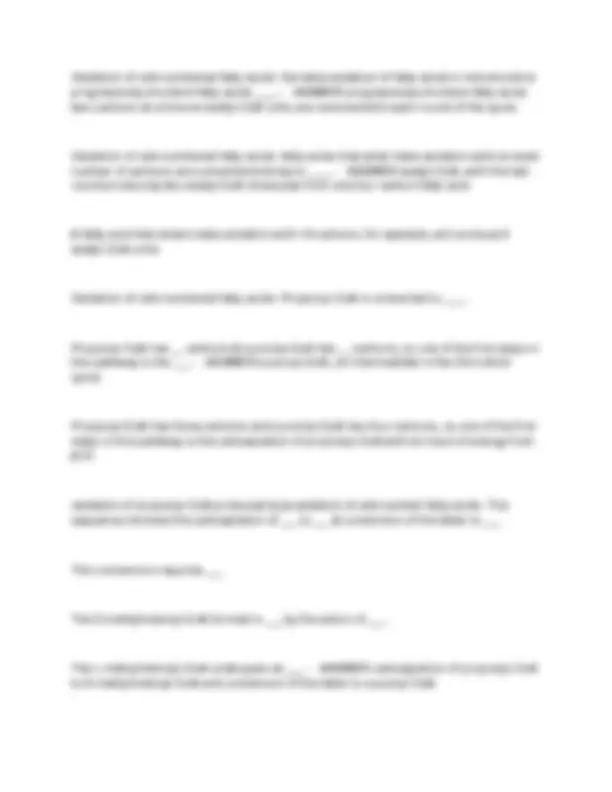
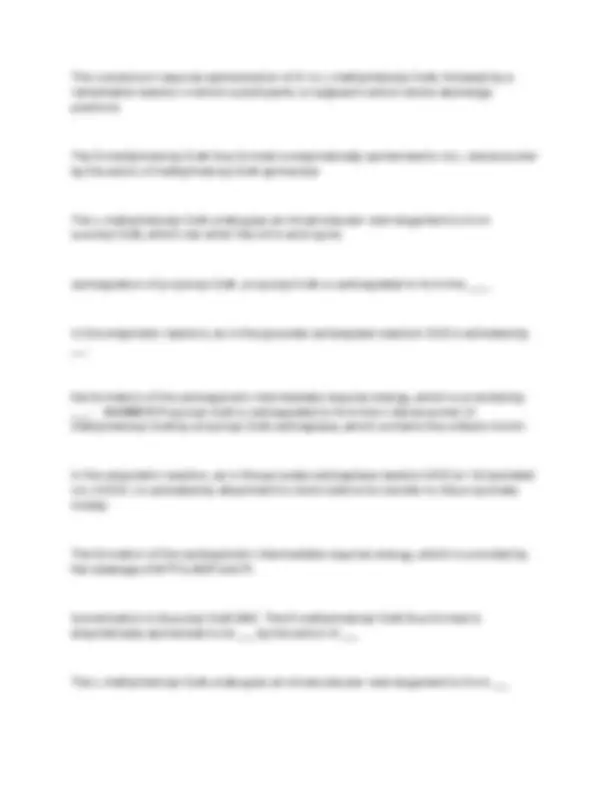
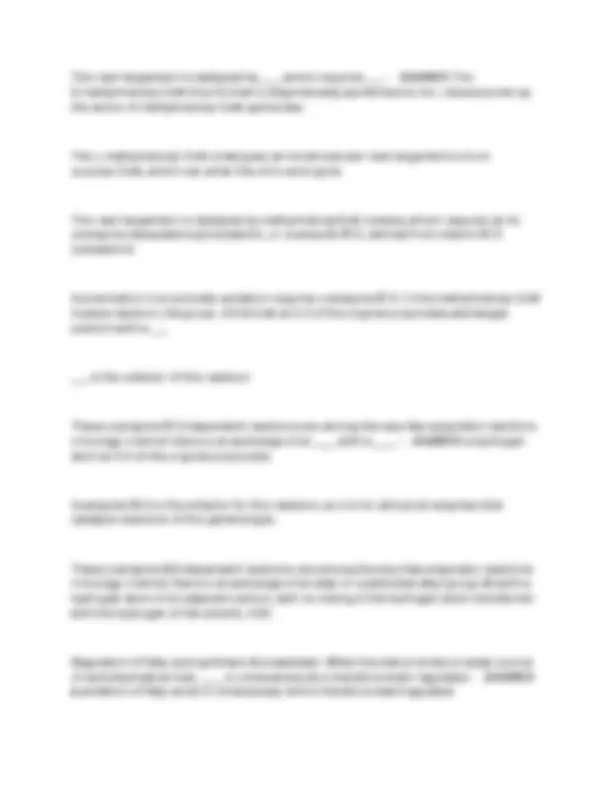
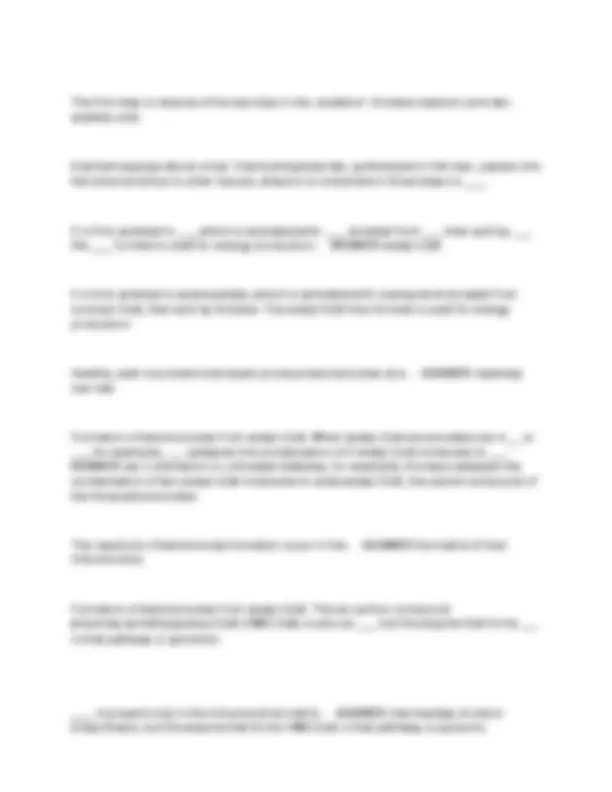
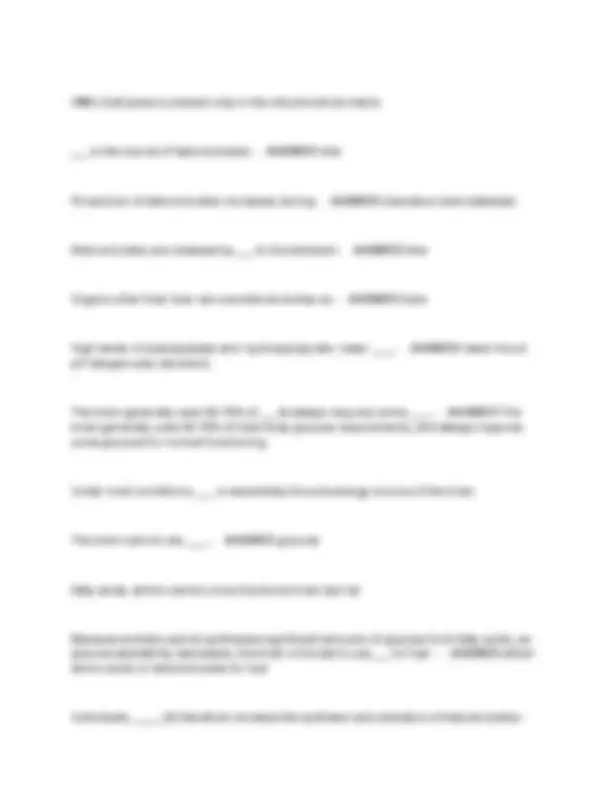
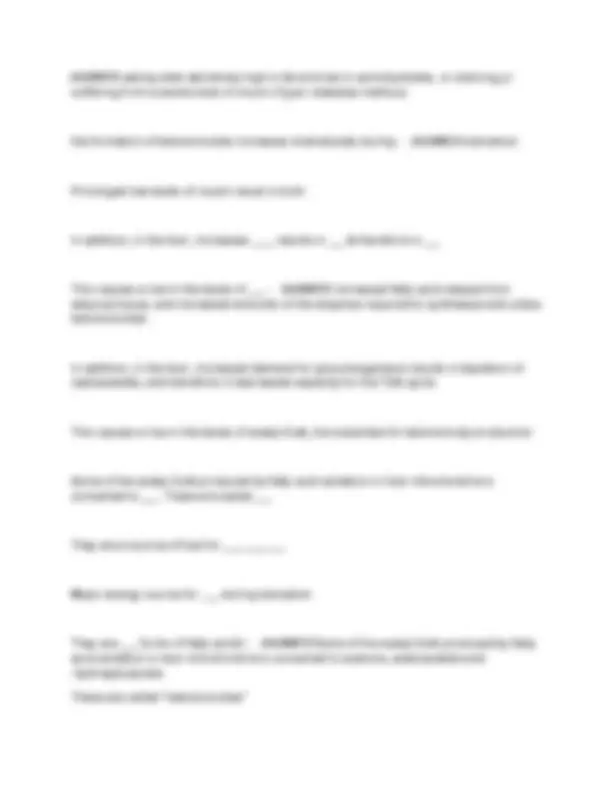
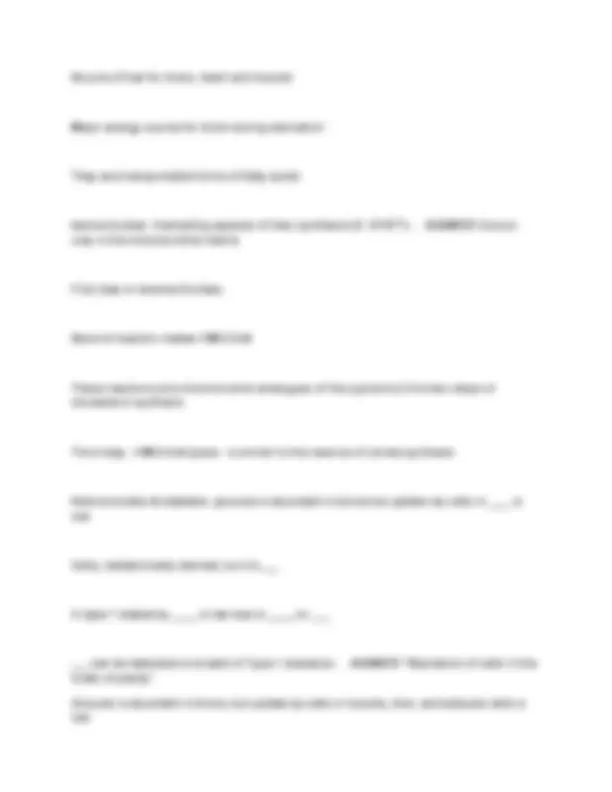
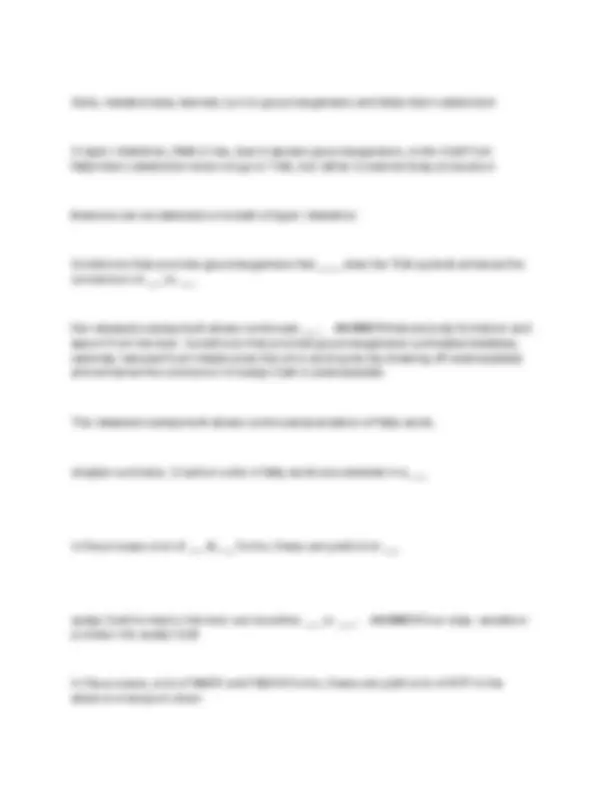



Study with the several resources on Docsity

Earn points by helping other students or get them with a premium plan


Prepare for your exams
Study with the several resources on Docsity

Earn points to download
Earn points by helping other students or get them with a premium plan
Community
Ask the community for help and clear up your study doubts
Discover the best universities in your country according to Docsity users
Free resources
Download our free guides on studying techniques, anxiety management strategies, and thesis advice from Docsity tutors
A detailed explanation of fatty acid catabolism, covering key processes like hydrolysis of triacylglycerols, mobilization of stored fats, glycerol entry into glycolysis, fatty acid activation, transport into mitochondria, and the stages of β-oxidation. It includes numerous solved exercises that reinforce understanding of the concepts and mechanisms involved in fatty acid breakdown.
Typology: Exams
1 / 23

This page cannot be seen from the preview
Don't miss anything!
















Hydrolysis of triacylglycerols is catalyzed by - ANSWER lipases Some lipase are regulated by: - ANSWER hormones glucagon and epinephrine Hydrolysis of fats yields - ANSWER fatty acids & glycerol Epinephrine means ___, glucagon means ___ -energy now" ANSWER Epinephrine means: "We need
Glucagon means: "We are out of glucose" ____ are also the major form of stored energy in the body - ANSWER Triglycerides Hormones ____ trigger the release of fatty acids from adipose tissue (3) -(glucagon, epinephrine, adrenocorticotropic hormone -ACTH) ANSWER
Mobilization of triacylglycerols stored in adipose tissue: 1) when low levels of glucose inthe blood trigger the release of glucagon, the hormone binds its receptor in the ____ & thus stimulates ____ -membrane and thus ANSWER the hormone binds its receptor in the adipocyte stimulates adenylyl cyclase, via a G protein, to produce cAMP Mobilization of triacylglycerols stored in adipose tissue: 2) This activates PKA, whichphosphorylates _____ - ANSWER which phosphorylates the hormone-sensitive lipase (HSL) and perilipin molecules on the surface of the lipid droplet.
Mobilization of triacylglycerols stored in adipose tissue: 3) Phosphorylation of perilipincauses ____. CGI then associates with ____ - ANSWER Phosphorylation of perilipin causes dissociation of the protein CGI from perilipin. CGI then associates with theenzyme adipose triacylglycerol lipase (ATGL), activating it.
Mobilization of triacylglycerols stored in adipose tissue: 4) Active ATGL converts ___ to____. The phosphorylated perilipin associates with ____, allowing it access to the surface of _____ -phosphorylated perilipin associates with phosphorylated HSL, allowing it access to the ANSWER Active ATGL converts triacylglycerols to diacylglycerols. The surface of the lipid droplet, where it converts diacylglycerols to monoacylglycerols. Mobilization of triacylglycerols stored in adipose tissue: 5) A third lipase, ____,hydrolyzes ____ - ANSWER A third lipase, monoacylglycerol lipase (MGL) hydrolyzes monoacylglycerols. Mobilization of triacylglycerols stored in adipose tissue: 6) Fatty acids leave the ____,bind ____ in the blood, & are carried in the blood; they are released from the ____ & enter a ____ -are carried in the blood; they are released from the albumin and ] ANSWER Fatty acids leave the adipocyte, bind serum albumin in the blood, and enter a myocyte via a specific fatty acid transporter. ] Mobilization of triacylglycerols stored in adipose tissue: 7) In the myocyte, fatty acidsare oxidized to ___ & the energy of oxidation is conserved in ATP, which fuels _____ - ANSWER In the myocyte, fatty acids are oxidized to CO2, and the energy of oxidation isconserved in ATP, which fuels muscle contraction and other energy-requiring metabolism in the myocyte. Glycerol from fats enters glycolysis: ____ activates glycerol at the expense of ATP Subsequent reactions recover _____ Allows limited ____
Acyl-adenylate intermediate conversion of a fatty acid to a fatty acyl-CoA is catalyzed by & -acyl-CoA synthetase and inorganic pyrophosphatase ANSWER fatty
Fatty acid activation by formation of the fatty acyl-CoA derivative occurs in ____. Theoverall reaction is highly ____ - ANSWER two steps. The overall reaction is highly exergonic. Fats are degraded into ___ & ___ in the cytoplasm of adipocytes -and glycerol ANSWER fatty acids
Fatty acid transport into mitochondria: fatty acids are transported to other tissues forfuel- oxidation of fatty acids occurs in ____ - ANSWER oxidation of fatty acids occurs in mitochondria Small (<12 carbons) fatty acids diffuse ____ Larger fatty acids (most free fatty acids) are transported via -across mitochondrial membranes ANSWER diffuse freely
transported via acyl-carnitine/carnitine transporter Fatty acid entry into mitochondria via the acyl-carnitine/carnitine transporter: After fattyacyl-carnitine is formed at the ____, it moves into the ____ by ____ - ANSWER the outer membrane or in the intermembrane space, it moves into the matrix by facilitateddiffusion through the transporter in the inner membrane
Fatty acid entry into mitochondria via the acyl-carnitine/carnitine transporter: In thematrix, the acyl group is transferred to ____, freeing ___ to return to the ____ - ANSWER In the matrix, the acyl group is transferred to mitochondrial coenzyme A, freeing
carnitine to return to the intermembrane space through the same transporter. Fatty acid entry into mitochondria via the acyl-carnitine/carnitine transporter:Acyltransferase I is inhibited by ____. This inhibition prevents ____ - ANSWER Acyltransferase I is inhibited by malonyl-CoA, the first intermediate in fatty acidsynthesis. This inhibition prevents the simultaneous synthesis and degradation of fatty acids. stages of fatty acid oxidation: Stages 1 consists of ___, involves ____ -consists of oxidative conversion of two-carbon units into acetyl-CoA via ANSWER Stage 1 β-oxidation with concomitant generation of NADH and FADH involves oxidation of β carbon to thioester of fatty acyl-CoA Stages of fatty acid oxidation: Stage 2 involves -CO2 via citric acid cycle with concomitant generation NADH and FADH2 ANSWER oxidation of acetyl-CoA into
Stages of fatty acid oxidation: Stage 3 generates -FADH2 via the respiratory chain ANSWER ATP from NADH and
Acyl-CoA oxidized to anANSWER FAD-dependent acyl-CoA dehydrogenase α, β unsaturated acyl-CoA: this reaction is catalyzed by -
Acyl-CoA oxidized to anproduce a ____, catalyzed by ____ - α, β unsaturated acyl-CoA: Unsaturated acyl-CoA is hydrated to ANSWER a β-hydroxyacyl-CoA catalyzed by the enzyme enoyl-CoA hydratase. Acyl-CoA oxidized to anproduce ____ by ____ - ANSWER Second oxidation reaction to produceα, β unsaturated acyl-CoA: Second oxidation reaction to β-ketoacyl-CoA by β-hydroxyacyl-CoA dehydrogenase. Acyl-CoA oxidized to an α, β unsaturated acyl-CoA: β-ketoacyl-CoA is cleaved by ___
(C16), which enters as palmitoyl-CoA. (b) Six more passes through the pathway yield seven more molecules of acetyl-CoA, theseventh arising from the last two carbon atoms of the 16-carbon chain. Eight molecules of acetyl-CoA are formed in all. Each pass removes one acetyl moiety in the form of acetyl-CoA Step 1:Dehydrogenation of Alkane to Alkene: catalyzed by ___
Results in ____ Analogous to ___ Electrons from bound FAD transferred directly to ____ -isoforms of acyl-CoA dehydrogenase (AD) on the inner-mitochondrial membrane ANSWER Catalyzed by
Results in trans double bond, different from naturally occurring unsaturated fatty acids Analogous to succinate dehydrogenase reaction in the citric acid cycle Electrons from bound FAD transferred directly to the electron- transport chain viaelectron-transferring flavoprotein (ETF)
Step 2:Hydration of Alkene: catalyzed by 2 ____
Water adds ____
Analogous to ____ Same ____ - ANSWER Catalyzed by two isoforms of enoyl-CoA hydratase: Soluble short-chain hydratase (crotonase)Membrane-bound long-chain hydratase, part of trifunctional complex
Water adds across the double bond yielding alcohol Analogous to fumarase reaction in the citric acid cycle Same stereospecificity Step 3:Dehydrogenation of Alcohol: catalyzed by ___
The enzyme uses ___ as the hydride acceptor Only ____ act as substrates Analogous to ____ - ANSWER Catalyzed by -hydroxyacyl-CoA dehydrogenase The enzyme uses NAD cofactor as the hydride acceptor Only L-isomers of hydroxyacyl CoA act as substrates Analogous to malate dehydrogenase reaction in the citric acid cycle
Electrons from all ___ & ___ enter ETC -process six more times (7 total) results in eight molecules of acetyl-CoA ANSWER Repeating the above four-step
FADH2 is formed in each cycle (7 total) NADH is formed in each cycle (7 total) Acetyl-CoA enters citric acid cycle and further oxidizes into CO This makes more GTP, NADH, and FADH Electrons from all FADH2 and NADH enter ETC Summary of Beta oxidation: Repetition of the cycle yields ____ Thus palmitic acid yields ___ Complete oxidation of 1 palmitic acid yields ___ molecules of ATP Large energy yield is consequence of the ____ This makes fatty acids the ____ - ANSWER a succession of acetate units Thus, palmitic acid yields eight acetyl-CoAs Complete -oxidation of one palmitic acid yields 106 molecules of ATP Large energy yield is consequence of the highly reduced state of the carbon in fattyacids
This makes fatty acids the fuel of choice for migratory birds and many other animals Oxidation of unsaturated fatty acids: naturally occurring unsaturated fatty acids contain___
they are NOT a substrate for 2 additional enzymes are required ____ Monounsaturated fatty acids require the ____ Polyunsaturated fatty acids require ____ - ANSWER contain cis double bonds Are NOT a substrate for enoyl-CoA hydratase Two additional enzymes are required Isomerase: converts cis double bonds starting at carbon 3 to trans double bondsReductase: reduces cis double bonds not at carbon 3
Monounsaturated fatty acids require the isomerase Polyunsaturated fatty acids require both enzymes Oxidation of a monounsaturated fatty acid: oxidation requires an additional enzyme ___,to reposition the ____, converting the cis isomer to a ___, - ANSWER additional enzyme, enoyl-CoA isomerase, to reposition the double bond, converting the cis isomer to atrans isomer, a normal intermediate in β oxidation.
Oxidation of a polyunsaturated fatty acid. Oxidation requires a ____.
Oxidation of odd-numbered fatty acids: the beta-oxidation of fatty acids in mitochondriaprogressively shortens fatty acids ____ - ANSWER progressively shortens fatty acids two-carbons at a time as acetyl-CoA units are removed with each round of the cycle. Oxidation of odd-numbered fatty acids: fatty acids that enter beta-oxidation with an evennumber of carbons are converted entirely to ____ - ANSWER acetyl-CoA, with the last round producing two acetyl-CoA molecules from one four carbon fatty acid. A fatty acid that enters beta-oxidation with 18 carbons, for example, will produce 9acetyl-CoA units.
Oxidation of odd-numbered fatty acids: Propionyl-CoA is converted to ____. Propionyl CoA has __ carbons & succinyl-CoA has __ carbons, so one of the first steps inthis pathway is the ___ - ANSWER succinyl-CoA, an intermediate in the Citric Acid cycle. Propionyl-CoA has three carbons and succinyl-CoA has four carbons, so one of the firststeps in this pathway is the carboxylation of propionyl-CoA with an input of energy from ATP. oxidation of propionyl CoA produced bysequence involves the carboxylation of ___ to ___ & conversion of the latter to ___ β oxidation of odd-number fatty acids. The
This conversion requires ___ The D-methylmalonyl-CoA formed is ___ by the action of ___. The L-methylmalonyl-CoA undergoes an ___ -to D-methylmalonyl-CoA and conversion of the latter to succinyl-CoA. ANSWER carboxylation of propionyl-CoA
This conversion requires epimerization of D- to L-methylmalonyl-CoA, followed by aremarkable reaction in which substituents on adjacent carbon atoms exchange positions The D-methylmalonyl-CoA thus formed is enzymatically epimerized to its L stereoisomerby the action of methylmalonyl-CoA epimerase.
The L-methylmalonyl-CoA undergoes an intramolecular rearrangement to formsuccinyl-CoA, which can enter the citric acid cycle.
carboxylation of propionyl-CoA: propionyl-CoA is carboxylated to form the ____ in this enzymatic reaction, as in the pyruvate carboxylase reaction CO2 is activated by___
the formation of the carboxybiotin intermediate requires energy, which is provided by___ - ANSWER Propionyl-CoA is carboxylated to form the n stereoisomer of methylmalonyl-CoA by propionyl-CoA carboxylase, which contains the cofactor biotin. In this enzymatic reaction, as in the pyruvate carboxylase reaction CO2 (or its hydratedion, HCO3- ) is activated by attachment to biotin before its transfer to the propionate moiety. The formation of the carboxybiotin intermediate requires energy, which is provided bythe cleavage of ATP to ADP and Pi.
Isomerization to Succinyl-CoA CAC: The D-methylmalonyl-CoA thus formed isenzymatically epimerized to its ___ by the action of ___
The L-methylmalonyl-CoA undergoes an intramolecular rearrangement to form ___
Regulation of FA synthesis & breakdown: 2 enzymes are key to the coordination of FAmetabolism: - ANSWER acetyl-CoA carboxylase (ACC), the first enzyme in the synthesis of fatty acids, and carnitine acyltransferase I, which limits the transport offatty acids into the mitochondrial matrix for β oxidation.
Regulation of FA synthesis & breakdown: ingestion of a high carb meal raises the bloodglucose level & thus triggers the release of ___
Insulin dependent protein phosphatase ____ ACC, ___ ACC catalyzes the formation of ___ & ___, inhibits ___, thereby preventing ____ -ANSWER Ingestion of a high-carbohydrate meal raises the blood glucose level and thus triggers the release of insulin. Insulin dependent protein phosphatase dephosphorylates ACC, activating it. ACC catalyzes the formation of malonyl-CoA (the first intermediate of fatty acidsynthesis), and malonyl-CoA inhibits carnitine acyltransferase I, thereby preventing fatty acid entry into the mitochondrial matrix. Regulation of FA synthesis & breakdown: when blood glucose levels drop betweenmeals, ____ release activates ____
The concentration of ____falls, the ___ is relieved, & fatty acids enter the ____ Bc glucagon also triggers the mobilization of fatty acids in adipose tissue... -when blood glucose levels drop between meals, glucagon release activates ANSWER cAMP-dependent protein kinase (PKA), which phosphorylates and inactivates ACC. The concentration of malonyl-CoA falls, the inhibition of fatty acid entry intomitochondria is relieved, and fatty acids enter the mitochondrial matrix and become the major fuel.
Because glucagon also triggers the mobilization of fatty acids in adipose tissue, asupply of fatty acids begins arriving in the blood.
Most of the acetyl-CoA produced by the oxidation of fatty acids in the liver mitochondriaundergoes ___.
However some of this acetyl-CoA is converted into 3 important metabolites: The process is known as ___ & the 3 metabolic are known as ____ -oxidation in the TCA cycle. ANSWER further
However some of this acetyl-CoA is converted into three important metabolities:acetone, acetoacetate and B-hydroxybutyrate.
The process is known as ketogenesis and the three metabolities are known as ketonebodies, despite the fact that b-hydroxbutyrate does not contain a ketone function.
Entry of acetyl-CoA into TCA cycle requires ___ when oxaloacetate is depleted, acetyl-Ca is converted into ___ frees Coenzyme A for ___ The first step is reverse of the last step in the ___ - ANSWER oxaloacetate When oxaloacetate is depleted, acetyl-CoA is converted into ketone bodies Frees Coenzyme A for continued β-oxidation
HMG-CoA lyase is present only in the mitochondrial matrix. ___ is the source of ketone bodies - ANSWER liver Production of ketone bodies increases during - ANSWER starvation (and diabetes) Ketone bodies are released by ___ to bloodstream - ANSWER liver Organs other than liver can use ketone bodies as - ANSWER fuels High levels of acetoacetate and -hydroxybutyrate: lower ____ -pH dangerously (acidosis) ANSWER lower blood
The brain generally uses 60-70% of ___ & always requires some ____ -brain generally uses 60-70% of total body glucose requirements, and always requires ANSWER The some glucose for normal functioning. Under most conditions, ___ is essentially the sole energy source of the brain. The brain cannot use ____ - ANSWER glucose fatty acids, which cannot cross the blood-brain barrier Because animals cannot synthesize significant amounts of glucose from fatty acids, asglucose availability decreases, the brain is forced to use ___ for fuel. - ANSWER either amino acids or ketone bodies for fuel Individuals _____ (3) therefore increase the synthesis and utilization of ketone bodies -
ANSWER eating diets extremely high in fat and low in carbohydrates, or starving,orsuffering from a severe lack of insulin (Type I diabetes mellitus)
the formation of ketone bodies increases dramatically during - ANSWER starvation Prolonged low levels of insulin result in both In addition, in the liver, increased ____ results in ___ & therefore in ___ This causes a rise in the levels of ___ -adipose tissue, and increased amounts of the enzymes required to synthesize and utilize ANSWER increased fatty acid release from ketone bodies. In addition, in the liver, increased demand for gluconeogenesis results in depletion ofoxaloacetate, and therefore in decreased capacity for the TCA cycle.
This causes a rise in the levels of acetyl-CoA, the substrate for ketone body production Some of the acetyl-CoA produced by fatty acid oxidation in liver mitochondria isconverted to ___. These are called ___
They are a source of fuel for ___, ___, ___ Major energy source for ___ during starvation They are ___ forms of fatty acids! -acid oxidation in liver mitochondria is converted to acetone, acetoacetate and ANSWER Some of the acetyl-CoA produced by fatty -hydroxybutyrateThese are called "ketone bodies"